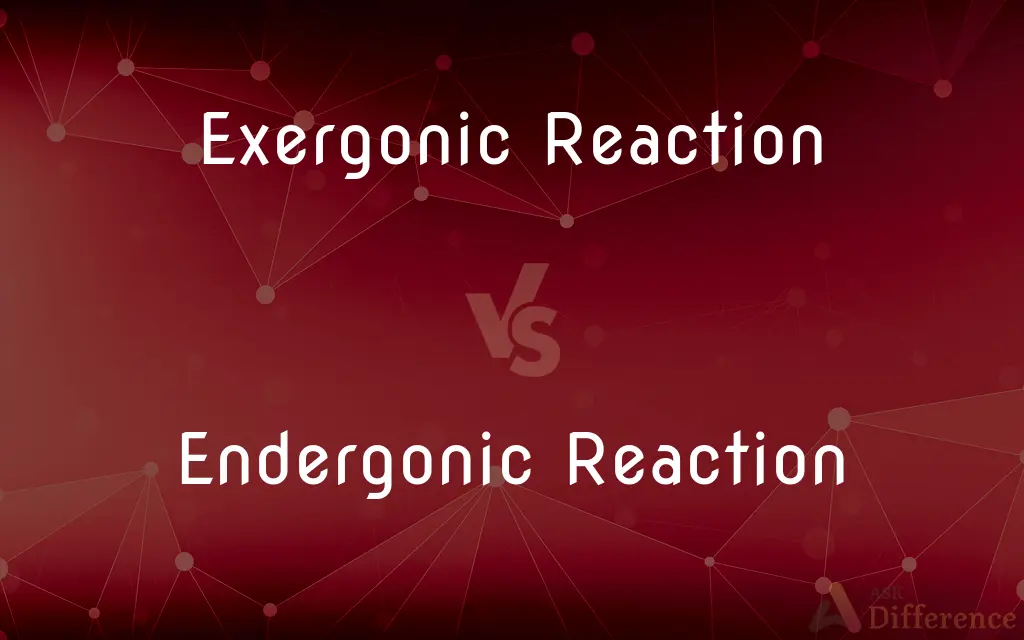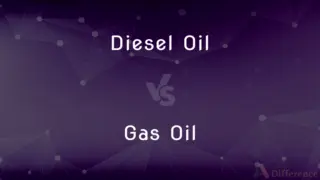Exergonic Reaction vs. Endergonic Reaction — What's the Difference?
By Urooj Arif & Fiza Rafique — Published on October 31, 2024
Exergonic reactions release energy during the process, making them spontaneous, whereas endergonic reactions absorb energy and require an external energy source to occur.

Difference Between Exergonic Reaction and Endergonic Reaction
Table of Contents
ADVERTISEMENT
Key Differences
Exergonic reactions are characterized by the release of energy, typically in the form of heat or light, making these reactions naturally spontaneous under standard conditions. This energy release is often utilized in cellular processes for work. On the other hand, endergonic reactions absorb energy from their surroundings, which is necessary for the reaction to proceed. These reactions are not spontaneous and rely on an input of energy, such as light or chemical energy, to drive them forward.
In terms of thermodynamics, exergonic reactions have a negative Gibbs free energy indicating that the process can occur without the need for energy input. This negative also signifies that the products of the reaction have less free energy than the reactants, showing the direction of spontaneity. Conversely, endergonic reactions have a positive Gibbs free energy, meaning that the products have more free energy than the reactants, and energy must be supplied for the reaction to occur.
Exergonic reactions are commonly found in catabolic processes, where complex molecules are broken down into simpler ones, releasing energy that the organism can use. In contrast, endergonic reactions are typical of anabolic processes, where simple molecules are assembled into more complex ones, necessitating an input of energy for the synthesis.
The energy released by exergonic reactions often fuels endergonic reactions, creating a coupled reaction system within biological organisms. This coupling allows for the efficient use of energy within cells, ensuring that energy-demanding processes can proceed. Whereas, without such coupling, endergonic reactions would not occur spontaneously, hindering essential biological functions.
Rate of reaction for exergonic reactions can vary; not all exergonic reactions occur quickly as activation energy can still be a barrier. Meanwhile, endergonic reactions always require energy input to overcome the activation energy barrier, making their rate dependent on the amount of energy available and the mechanism of energy input.
ADVERTISEMENT
Comparison Chart
Energy Change
Releases energy (ΔG<0)
Absorbs energy (ΔG>0)
Spontaneity
Spontaneous
Non-spontaneous, requires energy input
Common Processes
Catabolic processes (breaking down molecules)
Anabolic processes (building up molecules)
Coupling with Other Reactions
Can fuel endergonic reactions
Often coupled with exergonic reactions for energy
Example
Combustion of glucose
Photosynthesis, synthesis of ATP
Compare with Definitions
Exergonic Reaction
Can occur with or without a catalyst.
Enzymes speed up the exergonic reaction rates in biological systems.
Endergonic Reaction
Common in anabolic pathways.
The synthesis of starch from glucose is an endergonic reaction.
Exergonic Reaction
Characterized by a negative change in Gibbs free energy (ΔG<0).
The breakdown of glucose during cellular respiration is an exergonic process.
Endergonic Reaction
A reaction that absorbs energy from its surroundings.
The synthesis of glucose from carbon dioxide in photosynthesis is an endergonic reaction.
Exergonic Reaction
Spontaneous under standard conditions.
The rusting of iron occurs spontaneously as an exergonic reaction.
Endergonic Reaction
Characterized by a positive change in Gibbs free energy (ΔG>0).
The formation of peptide bonds between amino acids is an endergonic process.
Exergonic Reaction
A reaction that releases energy to the surroundings.
The combustion of wood in a fireplace is an exergonic reaction producing heat and light.
Endergonic Reaction
Dependent on energy sources such as ATP.
Muscle contraction is powered by the endergonic reaction of ATP hydrolysis.
Exergonic Reaction
Common in catabolic pathways.
The hydrolysis of ATP to ADP is an exergonic reaction providing energy for cellular activities.
Endergonic Reaction
Requires an input of energy to proceed.
The active transport of ions across a cell membrane is driven by endergonic reactions.
Common Curiosities
Are endergonic reactions always slower than exergonic reactions?
Not necessarily; the rate depends on the reaction's activation energy and the presence of catalysts, not the direction of energy flow.
Can an exergonic reaction ever require an input of energy?
While exergonic reactions release energy overall, they may still require an initial input of energy (activation energy) to start.
Can a single process involve both exergonic and endergonic reactions?
Yes, many biological processes involve coupled exergonic and endergonic reactions for efficient energy transfer.
Do exergonic reactions always occur spontaneously?
They are spontaneous in terms of thermodynamics, but may require a catalyst to overcome the activation energy barrier quickly.
What determines if a reaction is exergonic or endergonic?
The sign of the Gibbs free energy change (ΔG); negative for exergonic, positive for endergonic.
How do cells use exergonic and endergonic reactions?
Cells couple these reactions to ensure that energy released by exergonic reactions is used to drive endergonic reactions.
Is photosynthesis an exergonic or endergonic process?
Photosynthesis is an endergonic process as it requires energy from sunlight to convert carbon dioxide and water into glucose.
Can endergonic reactions be made spontaneous?
Endergonic reactions cannot become spontaneous but can proceed when coupled with an exergonic reaction or supplied with energy.
How does temperature affect these reactions?
Temperature can affect the rate of both reaction types but does not change the fundamental energy dynamics of the reactions.
Are all catabolic reactions exergonic?
Yes, catabolic reactions typically release energy by breaking down complex molecules, classifying them as exergonic.
Can the direction of Gibbs free energy change under different conditions?
Yes, changing conditions such as temperature, pressure, and concentration can alter ΔG, potentially affecting spontaneity.
What is a coupled reaction?
A coupled reaction involves an exergonic reaction providing the energy required to drive an endergonic reaction.
What role does ATP play in these reactions?
ATP acts as an energy currency, often hydrolyzed in an exergonic reaction to drive an endergonic reaction.
Are all anabolic reactions endergonic?
Typically, yes, since anabolic reactions build complex molecules from simpler ones and require an input of energy.
What is activation energy in the context of these reactions?
Activation energy is the initial energy required to start a reaction, relevant for both exergonic and endergonic processes to overcome energy barriers.
Share Your Discovery

Previous Comparison
Diesel Oil vs. Gas Oil
Next Comparison
Cucumbers vs. PicklesAuthor Spotlight
Written by
Urooj ArifUrooj is a skilled content writer at Ask Difference, known for her exceptional ability to simplify complex topics into engaging and informative content. With a passion for research and a flair for clear, concise writing, she consistently delivers articles that resonate with our diverse audience.
Co-written by
Fiza RafiqueFiza Rafique is a skilled content writer at AskDifference.com, where she meticulously refines and enhances written pieces. Drawing from her vast editorial expertise, Fiza ensures clarity, accuracy, and precision in every article. Passionate about language, she continually seeks to elevate the quality of content for readers worldwide.













































